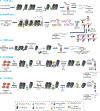Whole-genome methods to define DNA and histone accessibility and long-range interactions in chromatin
- PMID: 35166326
- PMCID: PMC9847230
- DOI: 10.1042/BST20210959
Whole-genome methods to define DNA and histone accessibility and long-range interactions in chromatin
Abstract
Defining the genome-wide chromatin landscape has been a goal of experimentalists for decades. Here we review highlights of these efforts, from seminal experiments showing discontinuities in chromatin structure related to gene activation to extensions of these methods elucidating general features of chromatin related to gene states by exploiting deep sequencing methods. We also review chromatin conformational capture methods to identify patterns in long-range interactions between genomic loci.
Keywords: ATAC-seq; CHIA-PET; CHIP-seq; FAIRE; HiC; whole-genome techniques.
© 2022 The Author(s). Published by Portland Press Limited on behalf of the Biochemical Society.
Conflict of interest statement
Competing Interests
The authors declare that there are no competing interests associated with the manuscript.
Figures



References
-
- Van Holde KE: Chromatin. New York: Springer-Verlag; 1989.
Publication types
MeSH terms
Substances
Grants and funding
LinkOut - more resources
Full Text Sources

